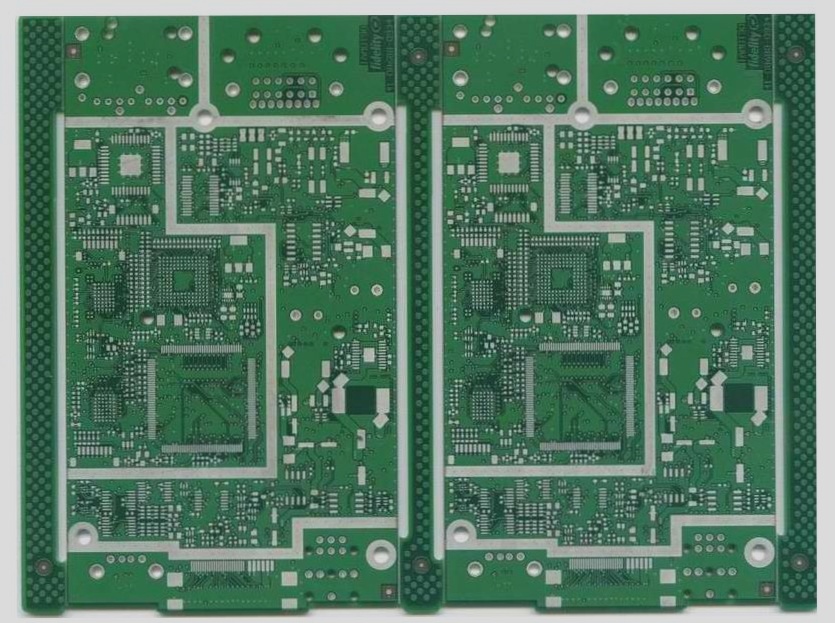4. The Influence of Medium Thickness
It is evident from the formula that the characteristic impedance is directly proportional to the natural logarithm of the dielectric thickness. Hence, it follows that an increase in dielectric thickness corresponds to a higher impedance value. Therefore, dielectric thickness stands as another primary factor influencing the characteristic resistance value. Given that wire width and the dielectric constant of the material are predetermined prior to production, the wire thickness process requirement can be regarded as a fixed value. Consequently, controlling the laminate thickness (dielectric thickness) emerges as the primary method for managing characteristic impedance during production. A graphical representation illustrates the relationship between characteristic impedance values and changes in dielectric thickness. The depicted figure demonstrates that a change of 0.025mm in the medium thickness yields a corresponding impedance shift of +5-8 ohms. In actual production, any permissible alteration in layer thickness significantly impacts the impedance value, potentially leading to substantial fluctuations. Varied types of prepregs are employed as insulating mediums during actual production, with the thickness of the insulating medium determined by the number of prepregs used. For instance, in the production process of surface microstrip lines, the dielectric constant of the insulating material at the relevant operating frequency is ascertained. Subsequently, the formula is utilized to compute the corresponding impedance value. Based on the wire width and impedance value specified by the user, the appropriate dielectric thickness is determined from the graph. Finally, the type and number of prepregs are determined based on the selected copper-clad laminate and copper foil thicknesses.
Furthermore, the design of microstrip line structures typically yields a higher characteristic impedance value compared to stripline designs with identical dielectric thickness and material, generally ranging between 20Ω-40Ω. Consequently, microstrip line structures find extensive use in high-frequency and high-speed digital signal transmission. Moreover, it is noted that the characteristic impedance value escalates with increasing medium thickness. Therefore, in circuits necessitating tightly controlled characteristic impedance values at high frequencies, stringent requirements must be imposed on the error margin of the copper-clad laminate’s dielectric thickness. Generally, the dielectric thickness of the copper-clad laminate should not deviate by more than 10%. For multilayer boards, dielectric thickness remains a significant process factor, especially concerning multi-layer lamination processing, and should thus be closely regulated.
5. Conclusion
In practical production, even slight variations in wire width, wire thickness, dielectric constant of the insulating material, and thickness of the insulating medium can induce changes in characteristic impedance. Additionally, other production factors also influence characteristic impedance. Therefore, to achieve the desired characteristic impedance, production controllers must comprehend the factors impacting characteristic impedance value changes, grasp the actual production circumstances, and adjust each process parameter according to the designer’s specifications to ensure that changes remain within acceptable tolerance limits, thereby achieving the desired impedance value.
It is evident from the formula that the characteristic impedance is directly proportional to the natural logarithm of the dielectric thickness. Hence, it follows that an increase in dielectric thickness corresponds to a higher impedance value. Therefore, dielectric thickness stands as another primary factor influencing the characteristic resistance value. Given that wire width and the dielectric constant of the material are predetermined prior to production, the wire thickness process requirement can be regarded as a fixed value. Consequently, controlling the laminate thickness (dielectric thickness) emerges as the primary method for managing characteristic impedance during production. A graphical representation illustrates the relationship between characteristic impedance values and changes in dielectric thickness. The depicted figure demonstrates that a change of 0.025mm in the medium thickness yields a corresponding impedance shift of +5-8 ohms. In actual production, any permissible alteration in layer thickness significantly impacts the impedance value, potentially leading to substantial fluctuations. Varied types of prepregs are employed as insulating mediums during actual production, with the thickness of the insulating medium determined by the number of prepregs used. For instance, in the production process of surface microstrip lines, the dielectric constant of the insulating material at the relevant operating frequency is ascertained. Subsequently, the formula is utilized to compute the corresponding impedance value. Based on the wire width and impedance value specified by the user, the appropriate dielectric thickness is determined from the graph. Finally, the type and number of prepregs are determined based on the selected copper-clad laminate and copper foil thicknesses.
Furthermore, the design of microstrip line structures typically yields a higher characteristic impedance value compared to stripline designs with identical dielectric thickness and material, generally ranging between 20Ω-40Ω. Consequently, microstrip line structures find extensive use in high-frequency and high-speed digital signal transmission. Moreover, it is noted that the characteristic impedance value escalates with increasing medium thickness. Therefore, in circuits necessitating tightly controlled characteristic impedance values at high frequencies, stringent requirements must be imposed on the error margin of the copper-clad laminate’s dielectric thickness. Generally, the dielectric thickness of the copper-clad laminate should not deviate by more than 10%. For multilayer boards, dielectric thickness remains a significant process factor, especially concerning multi-layer lamination processing, and should thus be closely regulated.
5. Conclusion
In practical production, even slight variations in wire width, wire thickness, dielectric constant of the insulating material, and thickness of the insulating medium can induce changes in characteristic impedance. Additionally, other production factors also influence characteristic impedance. Therefore, to achieve the desired characteristic impedance, production controllers must comprehend the factors impacting characteristic impedance value changes, grasp the actual production circumstances, and adjust each process parameter according to the designer’s specifications to ensure that changes remain within acceptable tolerance limits, thereby achieving the desired impedance value.


